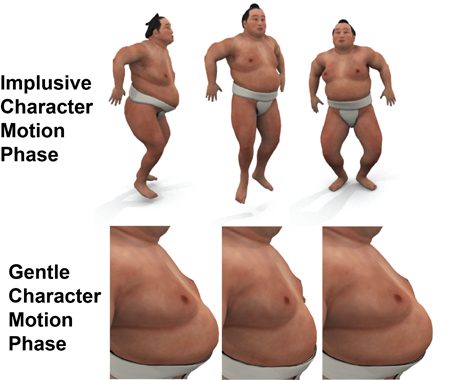 Nonlinear Material Design Using Principal Stretches
ACM SIGGRAPH 2015
Nonlinear Material Design Using Principal Stretches
ACM SIGGRAPH 2015

People
- Hongyi Xu
University of Southern California - Funshing Sin
University of Southern California
Blizzard Entertainment - Yufeng Zhu
University of Southern California
University of British Columbia - Jernej Barbič
University of Southern California
Project material
- Paper (PDF, 7.5 Mb)
- Video (Quicktime MP4, 62 Mb)
- Supplementary Video (Quicktime MP4, 5.4 Mb)
- SIGGRAPH 2015 Presentation Slides (zipped PPTX, 84 Mb)
Citation
-
Hongyi Xu, Funshing Sin, Yufeng Zhu, Jernej Barbič:
Interactive Material Design Using Model Reduction, ACM Transactions on Graphics 34(4) (SIGGRAPH 2015), August 2015. BIBTEX
Abstract
The Finite Element Method is widely used for solid deformable object simulation in film, computer games, virtual reality and medicine. Previous applications of nonlinear solid elasticity employed materials from a few standard families such as linear corotational, nonlinear St.Venant-Kirchhoff, Neo-Hookean, Ogden or Mooney-Rivlin materials. However, the spaces of all nonlinear isotropic and anisotropic materials are infinite-dimensional and much broader than these standard materials. In this paper, we demonstrate how to intuitively explore the space of isotropic and anisotropic nonlinear materials, for design of animations in computer graphics and related fields. In order to do so, we first formulate the internal elastic forces and tangent stiffness matrices in the space of the principal stretches of the material. We then demonstrate how to design new isotropic materials by editing a single stress-strain curve, using a spline interface. Similarly, anisotropic (orthotropic) materials can be designed by editing three curves, one for each material direction. We demonstrate that modifying these curves using our proposed interface has an intuitive, visual, effect on the simulation. Our materials accelerate simulation design and enable visual effects that are difficult or impossible to achieve with standard nonlinear materials.
Comments, questions to Jernej Barbič.Related projects
Funding
- NSF (CAREER-1055035, IIS-1422869)
- Sloan Foundation
- Intel Corporation (donation of two workstations)
- USC Annerberg Graduate Fellowship to Hongyi Xu
- USC James H. Zumberge Research and Innovation Fund
Disclaimer
Any opinions, findings, and conclusions or recommendations expressed in this material are those of the authors and do not necessarily reflect the views of the National Science Foundation.
Copyright notice
The documents contained in these directories are included by the contributing authors as a means to ensure timely dissemination of scholarly and technical work on a non-commercial basis. Copyright and all rights therein are maintained by the authors or by other copyright holders, notwithstanding that they have offered their works here electronically. It is understood that all persons copying this information will adhere to the terms and constraints invoked by each author's copyright. These works may not be reposted without the explicit permission of the copyright holder.
Unique accesses: